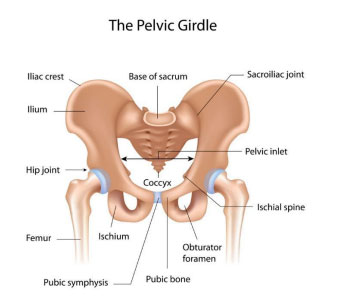Do you have difficulty sitting on both of your glutes? Do you find yourself sitting on one glute uncomfortably? If so, read the details below for causes, additional symptoms, diagnosis, and treatment of pelvic pain.
Causes
Many traumatic events can cause pelvic pain.
● Being t-boned by another motor vehicle
● Falling off a bicycle
● Being in a bicycle collision
● Having an accidental fall
Symptoms
● Pain in the groin or hip upon standing
● Pain in the genitalia area
● Difficulty sitting on hard surfaces
● Pain from standing for a prolonged period
● Pain in your upper glutes when walking
● Neuropathic pain in the groin (possible pudendal nerve compression)
● Uncontrolled fecal and urine incontinence
Diagnosis
When there is pain in one area of the pelvis, it is important to determine where the damage is located.
● You will need to follow up with your PCP or GP for a pelvic CT or MRI to assess damaged nerves.
o Damaged nerves in the sacral spinal cord will affect the bladder and bowels. If you are having urinary incontinence, then a referral to a urologist is recommended. For people who have fecal incontinence, a referral to a gastroenterologist (a specialist in diseases of the digestive system) and proctologist (a specialist in conditions of the rectum and anus) is needed.
Treatment
● If you are experiencing any of the symptoms listed above, I advise a follow up with your primary care physician (PCP) or general practitioner (GP) for a pelvic X-Ray to rule out any fractures and sacroiliitis.
● Sacroiliitis is inflammation in one or both sacroiliac joints.
o It is best treated with a sacroiliac joint injection that is performed by a pain management specialist using fluoroscopy.
● If fractures are present, your PCP or GP will refer you to an orthopedic specialist.
o Until the appointment date, you should not put any weight on the injured side.
o Crutches, a walker (toe-touch only), or wheelchair may be needed.
● Bladder and bowel retraining are a must for incontinence. These techniques have effectively helped stroke patients and patients who suffer from overactive bladder.
● NSAIDs and ice packs can be used as needed.

References
Alila Medical Media. (2019). Diagram of the pelvic girdle labeled. [Illustration]. Retrieved from https://www.shutterstock.com/image-illustration/diagram-pelvic-girdle-labeled147789479?src=WjptSJ5r5mjwwcqVvrylUQ-1-32
Sudoł-Szopińska, I., Kwiatkowska, B., Włodkowska-Korytkowska, M., Matuszewska, G., & Grochowska, E. (2015). Diagnostics of Sacroiliitis According to ASAS Criteria: A Comparative Evaluation of Conventional Radiographs and MRI in Patients with a Clinical Suspicion of Spondyloarthropathy. Preliminary Results. Polish journal of radiology, 80, 266–276. doi:10.12659/PJR.892529
